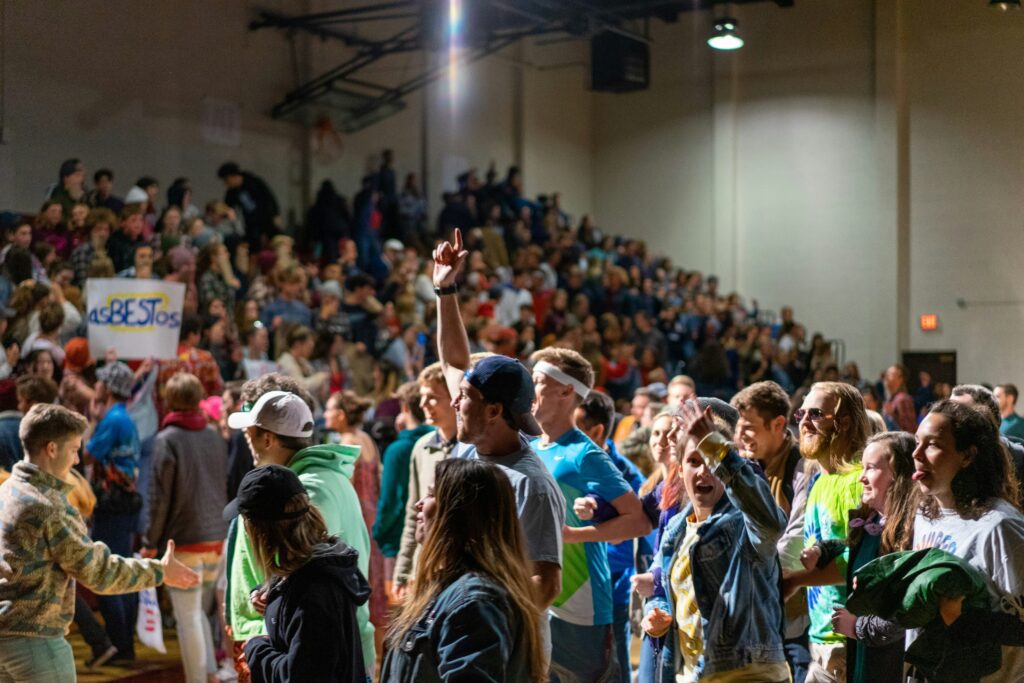Every youth pastor knows the scene: phones out, eyes down, minds wandering. But what if those same devices could become tools for deeper discipleship? CrowdVibe transforms the youth room dynamic by meeting students where they are—on their screens—and directing that attention toward spiritual growth.
The Youth Ministry Reality Check
Today’s teens and tweens are digital natives who process information differently than any previous generation. Research from Common Sense Media shows that teenagers spend an average of 7 hours and 22 minutes on screens daily. Fighting this reality is a losing battle. The winning strategy? Leverage it.
“We can either compete with technology or cooperate with it,” says Josh Griffin, veteran youth pastor and co-founder of Download Youth Ministry. “When we integrate interactive tools into our teaching, we’re speaking their language while teaching God’s truth.”
The statistics are sobering:
- Gen Z’s attention span for traditional lectures: 8 minutes
- Percentage who learn better through interactive media: 87%
- Youth who check phones during traditional lessons: 74%
- Students who report feeling disconnected during “sage on stage” teaching: 65%
From Icebreakers to Discipleship Makers
CrowdVibe excels at both ends of the youth ministry spectrum—creating fun moments that build community and facilitating deep spiritual conversations that change lives.
The Fun Factor
Middle schoolers live for competition and high schoolers crave connection. CrowdVibe delivers both:
Icebreaker Magic: “Would You Rather” polls that reveal hilarious preferences. “This or That” questions that get everyone laughing. Speed trivia about pop culture mixed with Bible facts. When 30 middle schoolers see that most of them prefer pizza over tacos, community begins.
Energy Builders: Youth groups that start with 5-question speed rounds—mixing random trivia with questions from last week’s lesson—report immediate energy shifts. Students arrive early because they don’t want to miss the opening game.
Team Competitions: Divide the room for epic battles. Track scores week-to-week. Create “houses” or teams that compete throughout the semester. The gamification keeps students coming back and, more importantly, paying attention.
The Depth Factor
But CrowdVibe’s real power emerges during teaching time:
Real-Time Temperature Checks: Anonymous polls reveal what students actually struggle with. “How many days this week did you read your Bible?” “What’s your biggest doubt about God?” The honesty in anonymous responses often shocks leaders—and creates teachable moments.
Scripture Engagement: Instead of passive Bible reading, students actively participate. “Which disciple do you relate to most?” “What would you have done in Peter’s situation?” Suddenly, ancient texts feel personally relevant.
Comprehension Confirmation: Quick quiz questions throughout the lesson ensure understanding. When most students miss a key concept, youth leaders can immediately re-explain rather than moving forward with confusion.
Middle School Mastery
Middle schoolers are squirrely, distracted, and desperate to belong. CrowdVibe addresses all three challenges.
With CrowdVibe, every 3-4 minutes students are doing something—voting, answering, competing. It’s like teaching in video game format, which resonates with this age group’s learning style.
Middle school wins with CrowdVibe:
- Movement Without Mayhem: Students engage actively while staying in their seats
- Inclusion for Introverts: Quiet kids participate without speaking up
- Instant Feedback: Leaders know immediately when they’ve lost the room
- Positive Peer Pressure: When students see that most of their peers pray daily, it normalizes spiritual disciplines
High School Depth
High schoolers crave authenticity and meaningful dialogue. CrowdVibe facilitates both:
Vulnerable Conversations: Anonymous polling about real struggles—depression, doubt, relationships—opens doors for ministry. When students see that many of their peers struggle with anxiety, they realize they’re not alone, and real ministry begins.
Theological Wrestling: Complex questions become group explorations. “Is doubt a sin?” “How do you know God’s will?” Students vote, discuss, then vote again after teaching—showing growth in real-time.
Life Application: End every lesson with commitment polls. “This week I will…” with specific options. Follow up the next week: “Who followed through?” Of course this is where it’s up to your personal approach as a youth leader—where accountability meets grace. You can balance the tone to be real and also lighthearted.
Breaking Through the Midweek Wall
The biggest challenge in youth ministry isn’t Wednesday night—it’s Thursday through Tuesday. CrowdVibe’s follow-up features transform how youth pastors maintain connection and momentum between gatherings.
“Sunday to Sunday is too long for spiritual formation,” explains Dr. Kara Powell from Fuller Youth Institute. “Students need midweek touchpoints that reinforce learning and maintain community. Interactive digital engagement makes this scalable and sustainable.”
The Wednesday-to-Wednesday Strategy
Interactive follow-ups that take 30 seconds to complete help keep students thinking about God throughout the week.
Monday Motivation: Send a quick poll about Sunday’s lesson application. “Who tried that prayer practice we learned? 🙏” Students see they’re not alone in their spiritual journey when results show their peers are also engaging.
Midweek Check-ins: Wednesday’s anonymous poll: “What’s your biggest struggle today?” Options might include: school stress, family conflict, friend drama, or faith doubts. The results often reveal ministry opportunities and prayer needs.
Friday Fun: Keep it light with trivia that mixes pop culture with preview questions for Sunday’s topic. “Which Marvel character best represents David’s courage against Goliath?” Engagement stays high when it’s enjoyable.
Weekend Readiness: Saturday polls prep hearts for Sunday: “What are you hoping God does in your life this week?” Creating anticipation increases attendance and attention.
Real Stories, Real Impact
Youth directors who send midweek check-ins find that students are more likely to share how God is working in their lives throughout the week, not just during youth group.
The midweek difference is clear:
- Students receiving interactive follow-ups show significantly higher completion of spiritual disciplines
- Most report feeling more connected to youth group throughout the week
- Bible reading notably increases with daily poll accountability
- Prayer consistency improves dramatically with midweek prompts
Strategic Implementation
Best Practices for Midweek Engagement:
- Keep it short: 1-2 questions maximum
- Vary the format: serious on Monday, fun on Friday
- Use anonymous options for vulnerable topics
- Share results to build community: “Many of your friends also struggled with patience this week”
- Connect to Sunday’s lesson for continuity
- Time sends strategically: after school for middle school, evening for high school
Creative Midweek Ideas:
- “Spot God” challenges: Poll about where students saw God working
- Prayer request polls that become youth group prayer focuses
- Daily Scripture votes: “Which verse helped you most today?”
- Accountability check-ins for lesson commitments
- Pre-youth group hype polls: “Who’s excited for tonight?”
Churches using CrowdVibe for midweek touchpoints report that students start viewing faith as a daily reality, not a weekly event.
The Science Behind the Success
Educational psychologist Dr. Barbara Oakley’s research reveals why interactive learning works especially well for adolescents:
- Teen brains are wired for social learning—seeing peer responses validates or challenges their thinking
- The adolescent reward system responds powerfully to gamification
- Short, varied activities match their cognitive development stage
- Anonymous participation reduces social anxiety while maintaining engagement
Youth who participate in interactive lessons show:
- Substantially better retention of biblical concepts
- Much higher likelihood of attending consistently
- Dramatically increased small group participation
- Notably stronger connection to their faith
Practical Implementation
Start small. Use one icebreaker game your first week. Add a single poll during your message the next. By month’s end, it’ll be seamless.
Best Practices:
- Mix fun and depth in every session
- Keep polls to 5-10 seconds for responses
- Display results immediately for discussion
- Save challenging questions for anonymous polling
- Use team competitions for energy, individual polls for reflection
- Follow up on concerning anonymous responses privately
Beyond Wednesday Night
CrowdVibe’s impact extends beyond youth group:
- Parents receive engagement reports showing what their teens learned
- Small group leaders get discussion questions based on poll responses
- Students can review quiz results to reinforce learning
- Youth pastors track spiritual growth through longitudinal data
The Bottom Line
Youth leaders using CrowdVibe report achieving complete engagement for entire lessons—no heads down, no side conversations, no ‘too cool’ attitudes. Students participate because it’s their language—interactive, immediate, and importantly, fun.
In a world where youth ministries compete with YouTube, TikTok, and countless digital distractions, CrowdVibe doesn’t fight the current—it harnesses it. The result? Students who don’t just attend youth group but actively participate in their faith formation.
The Apostle Paul became “all things to all people” to save some (1 Corinthians 9:22). In today’s digital age, that means meeting students on their screens and turning distraction into discipleship. With CrowdVibe, youth leaders finally have a tool that makes both fun and formation not just possible, but powerful.
The question isn’t whether your students will be on their phones during youth group—it’s whether those phones will draw them closer to Christ. With CrowdVibe, the answer is a resounding yes.



